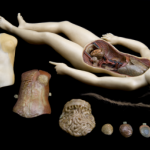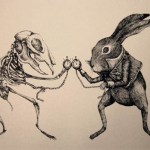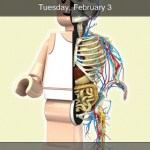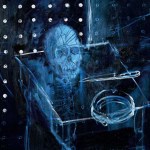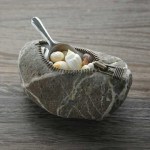Artists & Art
Wax anatomical figure of reclining woman, Florence, Italy, 1771-1800
Science Museum London
Starting today, the Wellcome Trust and sciencemuseum.org.uk open a brand spanking new collection of medical history archives. "Brought to Life: Exploring the History of Medicine" is searchable by people, place, thing, theme, and time. You can view a timeline of medical history in Europe next to similar timelines for the Islamic empire, Egypt and Greece (I do wish China and India were as prominently placed). You can read essays about larger questions, like what "wellness" means, or play with a cool…
My friend Nicole sent me this WSJ article about a month ago - it's about the sad reality that artworks made with nonarchival materials often don't outlive the artist:
Art is sold "as is" by galleries or directly from artists. (Can you imagine Consumer Reports reviewing art?) Still, dealers hope to maintain the goodwill of their customers, and artists don't want to develop a reputation for shoddy work. But it's not fully clear what responsibility artists bear to their completed work, especially after it has been sold. That's particularly the case for artists who purposefully use ephemeral…
"On Divination by Birds"
I don't need that black
wind of crows kicking up from flax to tell
heavy weather coming, white days to drop
barricades across the interstate,
against two hundred miles of trackless white.
(The crows so obvious then against the miles
of trackless white!) More tricky the magpies
flicker and croak at the sunken carcass
of a roadkill deer, raveling with beaks
the rubbery guts, picking gravel
from scant meat: there must be in their turn-taking
some pattern, some elegant design
beyond need, something in the raw trouble
of jays, the ragged braying geese flown south.
I gaze…
Lepidus timidus
Erica il Cane, 2007
Erica il Cane (AKA ericailcane AKA "Eric the dog") would be the perfect illustrator for that macabre children's book about vivisection that Edward Gorey should have written. In his etchings and drawings, adorable anthropomorphic creatures interact with labeled skeletons or watch as their own organs are neatly exposed. Disturbing, creepy, amusing, with a dash of pathos. Some of the drawings appear inspired by the European tradition of medical moulage - except instead of langorous, lovely women, these anatomical specimens resemble Teddy Ruxpin and his ilk…
Leonotis nepetaefolia and Doctor Humming Birds, Jamiaca
Marianne North (1830-1890)
Kew Royal Botanic Gardens
Sponsorship price: £1,000
832 paintings in the Marianne North Gallery at Britain's Kew Botanic Gardens are up for adoption. No, you don't get to name them or take them home - but you do get a print and other benefits.
All of these paintings are the work of Marianne North, a prolific and Victorian artist who traveled throughout the British empire documenting native flora and fauna in her own idiosyncratic style. Independently wealthy, North gave the gallery building and the…
Courier
mixed media, 2007
Thomas Doyle
Thomas Doyle's miniature sculptures are dead ringers for the moldering houses and threatening forests of HP Lovecraft's Arkham. Each 1:43 scale vignette is like a scene from a horror film - if horror films were staged in the lovingly crafted O-scale countryside of a miniature railroad diorama!
Acceptable losses
mixed media, 2008
Thomas Doyle
I discovered Doyle's work via party like an art star, the blog of art gallery manager Chloe Gallagher. As Gallagher notes, the tiny scale of Doyle's pieces draws you intimately in, while the glass domes act as a…
Ready for the weekend? Having trouble focusing? Indulge yourself in this luscious nine-minute film from the National Gallery of Art about Vermeer's masterpiece "The Music Lesson." It leisurely unpacks the painting's geometry and shadows, showing a glimpse of the techniques that let Vermeer make quotidian Delft resemble a gold-drenched daydream.
Vermeers are often described as highly realistic, crisp, even jewel-like. Although the illusion of reality is powerful, Vermeer, like all good artists, made judicious alterations to the scene before him. This video of "The Music Lesson" shows an…
Artist Jason Freeny asks us to suspend our disbelief for this mashup of two of my favorite things ever: anatomy and Lego. Surprisingly, after ripping the interchangeable heads and legs off hundreds of Lego people during my misspent youth, I find I can almost believe they *are* alive.
You can order Jason's poster here - he has also created posters for gummy bear anatomy and balloon animal anatomy. These would be excellent additions to a physiology teaching lab. Plus, Jason has created a free iPhone wallpaper of the Visible Lego Man, which is now on my phone:
Thanks, Jason!
Devana chasma
Peter Wasilewski
Dr. Peter Wasilewski, a NASA scientist, creates these beautiful photographs by passing polarized light through freezing films of water in Petri dishes. He calls the results "frizions":
The eye and brain combine the mixture of physical colors to produce a striking color impression. I began to control the way the ice grows, into forms I desired, always with color as my guide. Simple forms, detailed and complex forms, and forms that simply happened, as though I imagined them, established my medium. Ice growth became the landscape, and thickness and the polarizer…
The Pigeon of Passage
The Natural History of Carolina, Florida and the Bahama Islands, 1754
Mark Catesby
Unlike Benjamin Button, he's not up for an Oscar, but he's also a film star - several hundred years late. Mark Catesby (1683-1749), a forerunner of Audubon, was the first European scientist/artist to document the flora and fauna of North America. He depicted live specimens in their natural habitats, and made special study of both migration and extinction. You can view Catesby's masterwork, The Natural History of Carolina, Florida and the Bahama Islands, Vol 1 and Vol 2, at the University…
To follow up on my earlier post about Semiconductor's short film "Magnetic Movie," I want to share my favorite Semiconductor film: "Brilliant Noise." It gives me goosebumps every time I watch it.
In daily life, we avoid looking at the sun, but I challenge you to rip your eyes away from this film. In Semiconductor's hands, the sun is dynamic, unpredictable, even ominous. Quite the makeover for an object we take for granted!
More. . .
Brilliant Noise from Semiconductor on Vimeo.
Ruth Jarman and Joe Gerhardt
NASA Space Sciences Laboratory, UC Berkeley, California, USA. 2006
(click the four…
While I was at work, Sciencepunk beat me to posting that Damien Hirst (of dead-shark fame) has created an original artwork for the anniversary reissue of Darwin's On the Origin of Species:
Human skull in space (oil on canvas)
Damien Hirst
Hirst says:
As in a lot of my work, there's a nod to the scientific. The painting sits firmly in the tradition of "still life" and is made up of objects I've come to imbue with my own meanings, some of them Darwinian in origin, and that I guess are seen in other areas of my work. The painting has an X-ray-like quality to it, as if it is revealing something…
photo from TruShu's stream
Hirotoshi Itoh
Keiko Gallery
The author and title have long slipped my mind, but I once saw a poem lamenting how arbitrary we can be in calling certain things alive, and others not. Though many of them contain remnants of life, biologically speaking, stones are not alive. But who has felt a smooth, ancient pebble warm against the cupped palm, without feeling some affinity - some sense of a shared heritage?
Hirotoshi Itoh's sculptures tap into the numinous sense that stones, too, live. But he's hardly all mystical and spiritual about it; in fact, he's downright…
Magnetic Movie
Semiconductor (Ruth Jarman and Joseph Gerhardt)
Last fall I stopped by the Hirshhorn Museum's Black Box theatre to watch a short film by Semiconductor (the artistic team of Ruth Jarman and Joseph Gerhardt). Magnetic Movie is a color-drenched, imaginative tour of Berkeley's Space Sciences Laboratory. The film is below the fold, but before you watch it, take a moment to consider your expectations when you're watching a film about "lab science". Ultimately, does this film transcend or offend those expectations? And what are your expectations for scientific art in general?…
Whether you love or hate modern art, you should find this amusing.
Via Eva Amsen at Expression Patterns, I discovered this hilarious TED performance by Ursus Wehrli, author of the rather scarce book Tidying Up Art and its sequel. A deadpan Wehrli rescues modern art masterpieces by Vincent Van Gogh, Keith Haring, Rene Magritte, Jasper Johns and others by restructuring them into clean, happy, sensibly organized graphics. He should start working on government next!
If the embedded video doesn't work, the link is here.
ScienceOnline09 kicks off tonight. Formerly known as the Duke Blogging Conference, it's a weekend of interactive sessions on science blogging with lots of Sciblings and others representing the science blogging collective. Follow along on the conference wiki or Scibling Bora's blog for all the details.
I am extremely disappointed that I am too sick to go and co-chair the arts sessions with Glendon Mellow, but I made the right decision, because I am not getting better - I spent Wednesday at the State of the Net conference only a few miles from home, and I was destroyed afterward. I'll be…
"I Want You To Want Me"
Jonathan Harris and Sep Kamvar
commissioned by the Museum of Modern Art for their "Design and the Elastic Mind" exhibition
Mining data from online dating profiles, Jonathan Harris and Sep Kamvar have created a romantic, bittersweet peek into the human psyche. This video tour of the "I Want You to Want Me" installation ends on an up note - apparently "intelligence" is the top turn-on for online daters! Still, the sight of all those balloons bumping randomly past each other in the sky serves as a reminder that finding love anywhere, online or in meatspace, is a total…
Without Hope
Frida Kahlo, 1945
Museo Dolores Olmedo Patino, Mexico City
I ran across an extremely interesting article by Richard and Maureen Park in the December BMJ. It focuses on the decidedly unfestive procedure of force-feeding via funnel, and how that medical procedure has been represented in art. I don't think I've ever really thought about this topic before in a medical context.
The term "gavage," from the French "to gorge," is used to describe the force feeding of ducks and geese for the production of pâté de foie gras using funnels. For many centuries funnels have also been…
Artist Kim Boske's photography captures disturbing moments of predation - moments from which most of us would rather avert our eyes.
Via IBL3D
Assuming you have some downtime to digest, vegetate, and recover from the holidays, here's a cookie plate of links. Enjoy!
Boing Boing Gadgets presents "How it works. . . The Computer." Hilarious.
Via Morbid Anatomy, I found Monster Brains' repository of Krampus ephemera. For those in blissful ignorance, the Krampus is a grotesque devil figure that abuses young children as part of traditional Christmas festivities in Germany. Yikes!
Speaking of children, these vintage illustrations are, um, shocking:
From "30 ways to die of electrocution" flickr set by bre pettis.
Erratic Phenomena has…
